A Comparison of Three-Layer and Single-Layer Small Vascular Grafts Manufactured via the Roto-Evaporation Method
Abstract
1. Introduction
2. Materials and Methods
2.1. Materials
2.2. Synthesis of Segmented Polyurethanes
2.3. Physicochemical Characterization
2.4. Rationale/Justification of the Roto-Evaporation Technique for Manufacturing Vascular Grafts
2.5. Fabrication of Polyurethane Three-Layer Vascular Graft
2.6. Mechanical Properties of Polyurethane Films and Vascular Grafts
2.6.1. Tensile Properties of Polyurethane Films
2.6.2. Tensile Properties of Vascular Grafts
2.6.3. Burst Strength
2.6.4. Compliance
2.6.5. Suture Retention Strength
2.7. Scanning Electronic Microscopy (SEM)
2.8. Biological Characterization of Pristine Polyurethanes
2.8.1. Screening Test for Cytocompatibility
2.8.2. Cell Adhesion and Proliferation
2.8.3. Clot Formation
2.8.4. Hemolysis
2.9. Statistical Analysis
3. Results and Discussion
3.1. Physicochemical Characterization
3.2. Tensile Properties of Films and Tubes
3.3. Burst Strenght
3.4. Fracture Surfaces of Vascular Grafts after Mechanical Testing
3.5. Biological Performance
3.5.1. MDA-MB-231 Cytocompatibility
3.5.2. Cell Adhesion and Proliferation
3.5.3. Hemocompatibility
4. Conclusions
Author Contributions
Funding
Institutional Review Board Statement
Data Availability Statement
Acknowledgments
Conflicts of Interest
References
- Clerkin, K.J.; Fried, J.A.; Raikhelkar, J.; Sayer, G.; Griffin, J.M.; Masoumi, A.; Jain, S.S.; Burkhoff, D.; Kumaraiah, D.; Rabbani, L.R.; et al. COVID-19 and Cardiovascular Disease. Circulation 2020, 141, 1648–1655. [Google Scholar] [CrossRef] [PubMed]
- WHO. World Health Statistics 2022: Monitoring Health for the SDGs, Sustainable Development Goals. Available online: https://www.who.int/publications/i/item/9789240051157 (accessed on 19 January 2023).
- Pashneh-Tala, S.; MacNeil, S.; Claeyssens, F. The Tissue-Engineered Vascular Graft—Past, Present, and Future. Tissue Eng. Part. B Rev. 2016, 22, 68–100. [Google Scholar] [CrossRef] [PubMed]
- Mallis, P.; Kostakis, A.; Stavropoulos-Giokas, C.; Michalopoulos, E. Future Perspectives in Small-Diameter Vascular Graft Engineering. Bioengineering 2020, 7, 160. [Google Scholar] [CrossRef] [PubMed]
- Conte, S.M.; Vale, P.R. Peripheral Arterial Disease. Heart Lung Circ. 2018, 27, 427–432. [Google Scholar] [CrossRef] [PubMed]
- Leal, B.B.J.; Wakabayashi, N.; Oyama, K.; Kamiya, H.; Braghirolli, D.I.; Pranke, P. Vascular Tissue Engineering: Polymers and Methodologies for Small Caliber Vascular Grafts. Front. Cardiovasc. Med. 2021, 7, 592361. [Google Scholar] [CrossRef] [PubMed]
- Caliskan, E.; de Souza, D.R.; Böning, A.; Liakopoulos, O.J.; Choi, Y.H.; Pepper, J.; Gibson, C.M.; Perrault, L.P.; Wolf, R.K.; Kim, K.B.; et al. Saphenous Vein Grafts in Contemporary Coronary Artery Bypass Graft Surgery. Nat. Rev. Cardiol. 2020, 17, 155–169. [Google Scholar] [CrossRef] [PubMed]
- Zierler, R.E.; Jordan, W.D.; Lal, B.K.; Mussa, F.; Leers, S.; Fulton, J.; Pevec, W.; Hill, A.; Murad, M.H. The Society for Vascular Surgery Practice Guidelines on Follow-up after Vascular Surgery Arterial Procedures. J. Vasc. Surg. 2018, 68, 256–284. [Google Scholar] [CrossRef] [PubMed]
- L’Heureux, N.; Dusserre, N.; Marini, A.; Garrido, S.; de la Fuente, L.; McAllister, T. Technology Insight: The Evolution of Tissue-Engineered Vascular Grafts-From Research to Clinical Practice. Nat. Clin. Pract. Cardiovasc. Med. 2007, 4, 389–395. [Google Scholar] [CrossRef] [PubMed]
- Harskamp, R.E.; Lopes, R.D.; Baisden, C.E.; De Winter, R.J.; Alexander, J.H. Saphenous Vein Graft Failure after Coronary Artery Bypass Surgery: Pathophysiology, Management, and Future Directions. Ann. Surg. 2013, 257, 824–833. [Google Scholar] [CrossRef]
- Mi, H.Y.; Jing, X.; Yu, E.; Wang, X.; Li, Q.; Turng, L.S. Manipulating the Structure and Mechanical Properties of Thermoplastic Polyurethane/Polycaprolactone Hybrid Small Diameter Vascular Scaffolds Fabricated via Electrospinning Using an Assembled Rotating Collector. J. Mech. Behav. Biomed. Mater. 2018, 78, 433–441. [Google Scholar] [CrossRef]
- Voorhees, A.B.; Jaretzki, A.; Blakemore, A.H. The Use of Tubes Constructed from Vinyon “N” Cloth in Bridging Arterial Defects. Ann. Surg. 1952, 135, 332–336. [Google Scholar] [CrossRef] [PubMed]
- DeBakey, M.E.; Crawford, E.S.; Garrett, H.E.; Beall, A.C.; Howell, J.F. Surgical Considerations in the Treatment of Aneurysms of the Thoraco-Abdominal Aorta. Ann. Surg. 1965, 162, 650–662. [Google Scholar] [CrossRef] [PubMed]
- Sarkar, S.; Sales, K.M.; Hamilton, G.; Seifalian, A.M. Addressing Thrombogenicity in Vascular Graft Construction. J. Biomed. Mater. Res. B Appl. Biomater. 2007, 82, 100–108. [Google Scholar] [CrossRef]
- Berger, K.; Sauvage, L.R. Late Fiber Deterioration in Dacron® Arterial Grafts. Ann. Surg. 1981, 193, 477–491. [Google Scholar]
- Weber, C.; Reinhardt, S.; Eghbalzadeh, K.; Wacker, M.; Guschlbauer, M.; Maul, A.; Sterner-Kock, A.; Wahlers, T.; Wippermann, J.; Scherner, M. Patency and in Vivo Compatibility of Bacterial Nanocellulose Grafts as Small-Diameter Vascular Substitute. J. Vasc. Surg. 2018, 68, 177S–187S.e1. [Google Scholar] [CrossRef]
- Fang, S.; Ellman, D.G.; Andersen, D.C. Review: Tissue Engineering of Small-Diameter Vascular Grafts and Their In Vivo Evaluation in Large Animals and Humans. Cells 2021, 10, 713. [Google Scholar] [CrossRef]
- Baguneid, M.S.; Seifalian, A.M.; Salacinski, H.J.; Murray, D.; Hamilton, G.; Walker, M.G. Tissue Engineering of Blood Vessels. Br. J. Surg. 2006, 93, 282–290. [Google Scholar] [CrossRef]
- Joseph, J.; Patel, R.M.; Wenham, A.; Smith, J.R. Biomedical Applications of Polyurethane Materials and Coatings. Trans. Inst. Met. Finish. 2018, 96, 121–129. [Google Scholar] [CrossRef]
- Wendels, S.; Avérous, L. Biobased Polyurethanes for Biomedical Applications. Bioact. Mater. 2021, 6, 1083–1106. [Google Scholar] [CrossRef]
- Szycher, M. Polyurethanes: Medical Applications. In Encyclopedia of Biomedical Polymers and Polymeric Biomaterials; CRC Press: Boca Raton, FL, USA, 2016; pp. 6647–6670. [Google Scholar]
- Padsalgikar, A.D. Applications of Polyurethanes in Medical Devices. In Applications of Polyurethanes in Medical Devices; Elsevier Inc.: Amsterdam, The Netherlands, 2022; pp. 1–269. [Google Scholar] [CrossRef]
- Hsu, S.H.; Xu, J.; Lin, S.H.; Wu, S.D.; Cheng, Q.P.; Wong, C.W. Creative Transformation of Biomedical Polyurethanes: From Biostable Tubing to Biodegradable Smart Materials. J. Polym. Res. 2022, 29, 70. [Google Scholar] [CrossRef]
- Naureen, B.; Haseeb, A.S.M.A.; Basirun, W.J.; Muhamad, F. Recent Advances in Tissue Engineering Scaffolds Based on Polyurethane and Modified Polyurethane. Mater. Sci. Eng. C 2021, 118, 111228. [Google Scholar] [CrossRef]
- Adipurnama, I.; Yang, M.C.; Ciach, T.; Butruk-Raszeja, B. Surface Modification and Endothelialization of Polyurethane for Vascular Tissue Engineering Applications: A Review. Biomater. Sci. 2017, 5, 22–37. [Google Scholar] [CrossRef] [PubMed]
- Szczepańczyk, P.; Szlachta, M.; Złocista-Szewczyk, N.; Chłopek, J.; Pielichowska, K. Recent Developments in Polyurethane-Based Materials for Bone Tissue Engineering. Polymers 2021, 13, 946. [Google Scholar] [CrossRef] [PubMed]
- Herman, I.P. Physics of the Human Body; Johns Hopkins University Press: Baltimore, MD, USA, 2010; Volume 48, ISBN 9783319239309. [Google Scholar]
- Esmaeili, S.; Shahali, M.; Kordjamshidi, A.; Torkpoor, Z.; Namdari, F.; Samandari, S.S.-; Ghadiri Nejad, M.; Khandan, A. An Artificial Blood Vessel Fabricated by 3D Printing for Pharmaceutical Application. Nanomed. J. 2019, 6, 183–194. [Google Scholar] [CrossRef]
- Zhou, X.; Nowicki, M.; Sun, H.; Hann, S.Y.; Cui, H.; Esworthy, T.; Lee, J.D.; Plesniak, M.; Zhang, L.G. 3D Bioprinting-Tunable Small-Diameter Blood Vessels with Biomimetic Biphasic Cell Layers. ACS Appl. Mater. Interfaces 2020, 12, 45904–45915. [Google Scholar] [CrossRef]
- Zumbardo-Bacelis, G.A.; Meza-Villegas, L.A.; Pérez-Aranda, C.A.; Vargas-Coronado, R.; Castillo-Cruz, O.; Montaño-Machado, V.; Mantovani, D.; Cauich-Rodríguez, J.V. On Arginine-based Polyurethane-blends Specific to Vascular Prostheses. J. Appl. Polym. Sci. 2021, 138, 51247. [Google Scholar] [CrossRef]
- Asadpour, S.; Yeganeh, H.; Ai, J.; Ghanbari, H. A Novel Polyurethane Modified with Biomacromolecules for Small-Diameter Vascular Graft Applications. J. Mater. Sci. 2018, 53, 9913–9927. [Google Scholar] [CrossRef]
- Yuan, X.; Li, W.; Yao, B.; Li, Z.; Kong, D.; Huang, S.; Zhu, M. Tri-Layered Vascular Grafts Guide Vascular Cells’ Native-like Arrangement. Polymers 2022, 14, 1370. [Google Scholar] [CrossRef]
- Wu, C.; Wang, H.; Cao, J. Tween-80 Improves Single/Coaxial Electrospinning of Three-Layered Bioartificial Blood Vessel. J. Mater. Sci. Mater. Med. 2023, 34, 6. [Google Scholar] [CrossRef]
- Cetina-Diaz, S.M.; Chan-Chan, L.H.; Vargas-Coronado, R.F.; Cervantes-Uc, J.M.; Quintana-Owen, P.; Paakinaho, K.; Kellomaki, M.; Di Silvio, L.; Deb, S.; Cauich-Rodríguez, J.V. Physicochemical Characterization of Segmented Polyurethanes Prepared with Glutamine or Ascorbic Acid as Chain Extenders and Their Hydroxyapatite Composites. J. Mater. Chem. B 2014, 2, 1966–1976. [Google Scholar] [CrossRef]
- Fitzgerald, P.J.; St. Goar, F.G.; Connolly, A.J.; Pinto, F.J.; Billingham, M.E.; Popp, R.L.; Yock, P.G. Intravascular Ultrasound Imaging of Coronary Arteries: Is Three Layers the Norm? Circulation 1992, 86, 154–158. [Google Scholar] [CrossRef] [PubMed]
- Potkin, B.J.; Bartorelli, A.L.; Gessert, J.M.; Neville, R.F.; Almagor, Y.; Roberts, W.C.; Leon, M.B. Coronary Artery Imaging with Intravascular High-Frequency Ultrasound. Circulation 1990, 81, 1575–1585. [Google Scholar] [CrossRef] [PubMed]
- Mintz, G.S.; Nissen, S.E.; Anderson, W.D.; Bailey, S.R.; Erbel, R.; Fitzgerald, P.J.; Pinto, F.J.; Rosenfield, K.; Siegel, R.J.; Murat Tuzcu, E.; et al. American College of Cardiology Clinical Expert Consensus Document on Standards for Acquisition, Measurement and Reporting of Intravascular Ultrasound Studies (IVUS). J. Am. Coll. Cardiol. 2001, 37, 1478–1492. [Google Scholar] [CrossRef] [PubMed]
- Wong, M.; Edelstein, J.; Wollman, J.; Bond, M.G. Ultrasonic-Pathological Comparison of the Human Arterial Wall: Verification of Intima-Media Thickness. Arterioscler. Thromb. Vasc. Biol. 1993, 13, 482–486. [Google Scholar] [CrossRef]
- ASTM D882; Standard Test Method for Tensile Properties of Thin Plastic Sheeting. ASTM: West Conshohocken, PA, USA, 2018.
- ISO 7198; Cardiovascular Implants—Tubular Vascular Prostheses. International Organization for Standardization: Geneva, Switzerland, 1998.
- Pérez-Aranda, C.; Gamboa, F.; Castillo-Cruz, O.; Cauich-Rodríguez, J.V.; Avilés, F. Design and Analysis of a Burst Strength Device for Testing Vascular Grafts. Rev. Sci. Instrum. 2019, 90, 014301. [Google Scholar] [CrossRef] [PubMed]
- Voorneveld, J.; Oosthuysen, A.; Franz, T.; Zilla, P.; Bezuidenhout, D. Dual Electrospinning with Sacrificial Fibers for Engineered Porosity and Enhancement of Tissue Ingrowth. J. Biomed. Mater. Res. B Appl. Biomater. 2017, 105, 1559–1572. [Google Scholar] [CrossRef]
- Laterreur, V.; Ruel, J.; Auger, F.A.; Valliè, K.; Tremblay, C.; Lacroix, D.; Tondreau, M.; Bourget, J.-M.; Germain, L. Comparison of the Direct Burst Pressure and the Ring Tensile Test Methods for Mechanical Characterization of Tissue-Engineered Vascular Substitutes. J. Mech. Behav. Biomed. Mater. 2014, 34, 253–263. [Google Scholar] [CrossRef] [PubMed]
- Stankus, J.J.; Soletti, L.; Fujimoto, K.; Hong, Y.; Vorp, D.A.; Wagner, W.R. Fabrication of Cell Microintegrated Blood Vessel Constructs through Electrohydrodynamic Atomization. Biomaterials 2007, 28, 2738–2746. [Google Scholar] [CrossRef]
- ISO 10993-5; Biological Evaluation of Medical Devices—Part 5: Tests for in Vitro Cytotoxicity. International Organization for Standardization: Geneva, Switzerland, 2009.
- Huang, K.T.; Chen, Y.H.; Walker, A.M. Inaccuracies in MTS Assays: Major Distorting Effects of Medium, Serum Albumin, and Fatty Acids. Biotechniques 2004, 37, 406–412. [Google Scholar] [CrossRef]
- Ross, A.M.; Jiang, Z.; Bastmeyer, M.; Lahann, J. Physical Aspects of Cell Culture Substrates: Topography, Roughness, and Elasticity. Small 2012, 8, 336–355. [Google Scholar] [CrossRef]
- Karakaş, D.; Ari, F.; Ulukaya, E. The MTT Viability Assay Yields Strikingly False-Positive Viabilities Although the Cells Are Killed by Some Plant Extracts. Turk. J. Biol. 2017, 41, 919–925. [Google Scholar] [CrossRef] [PubMed]
- Sotolongo-García, R.; Rodríguez-Velázquez, E.; Alatorre-Meda, M.; Oropeza-Guzmán, M.T.; Tirado-Guízar, A.; Pina-Luis, G. Optimizing the Efficiency of a Cytocompatible Carbon-Dots-Based Fret Platform and Its Application as a Riboflavin Sensor in Beverages. Nanomaterials 2021, 11, 1981. [Google Scholar] [CrossRef] [PubMed]
- Montaño-Machado, V.; Chevallier, P.; Mantovani, D.; Pauthe, E. On the Potential for Fibronectin/Phosphorylcholine Coatings on PTFE Substrates to Jointly Modulate Endothelial Cell Adhesion and Hemocompatibility Properties. Biomatter 2015, 5, e979679. [Google Scholar] [CrossRef] [PubMed]
- ASTM F756-17; Standard Practice for Assessment of Hemolytic Properties of Materials. ASTM: West Conshohocken, PA, USA, 2017.
- Chan-Chan, L.H.; González-García, G.; Vargas-Coronado, R.F.; Cervantes-Uc, J.M.; Hernández-Sánchez, F.; Marcos-Fernandez, A.; Cauich-Rodríguez, J.V. Characterization of Model Compounds and Poly(Amide-Urea) Urethanes Based on Amino Acids by FTIR, NMR and Other Analytical Techniques. Eur. Polym. J. 2017, 92, 27–39. [Google Scholar] [CrossRef]
- Shababdoust, A.; Ehsani, M.; Shokrollahi, P.; Zandi, M. Fabrication of Curcumin-Loaded Electrospun Nanofiberous Polyurethanes with Anti-Bacterial Activity. Prog. Biomater. 2018, 7, 23–33. [Google Scholar] [CrossRef] [PubMed]
- Wang, F.C.; Feve, M.; Lam, T.M.; Pascault, J.P. FTIR Analysis of Hydrogen Bonding in Amorphous Linear Aromatic Polyurethanes. II. Influence of Styrene Solvent. J. Polym. Sci. B Polym. Phys. 1994, 32, 1315–1320. [Google Scholar] [CrossRef]
- Bruckmoser, K.; Resch, K. Investigation of Ageing Mechanisms in Thermoplastic Polyurethanes by Means of IR and Raman Spectroscopy. Macromol. Symp. 2014, 339, 70–83. [Google Scholar] [CrossRef]
- Weakley, A.T.; Warwick, T.; Bitterwolf, T.E.; Aston, D.E. Multivariate Analysis of Micro-Raman Spectra of Thermoplastic Polyurethane Blends Using Principal Component Analysis and Principal Component Regression. Appl. Spectrosc. 2012, 66, 1269–1278. [Google Scholar] [CrossRef] [PubMed]
- Johnson, J.; Ohst, D.; Groehl, T.; Hetterscheidt, S.; Jones, M. Development of Novel, Bioresorbable, Small-Diameter Electrospun Vascular Grafts. J. Tissue Sci. Eng. 2015, 6, 2. [Google Scholar] [CrossRef]
- Amabili, M.; Balasubramanian, P.; Ferrari, G.; Franchini, G.; Giovanniello, F.; Tubaldi, E. Identification of Viscoelastic Properties of Dacron Aortic Grafts Subjected to Physiological Pulsatile Flow. J. Mech. Behav. Biomed. Mater. 2020, 110, 103804. [Google Scholar] [CrossRef]
- L’Heureux, N.; Dusserre, N.; Konig, G.; Victor, B.; Keire, P.; Wight, T.N.; Chronos, N.A.F.; Kyles, A.E.; Gregory, C.R.; Hoyt, G.; et al. Human Tissue-Engineered Blood Vessels for Adult Arterial Revascularization. Nat. Med. 2006, 12, 361–365. [Google Scholar] [CrossRef] [PubMed]
- Salacinski, H.J.; Goldner, S.; Giudiceandrea, A.; Hamilton, G.; Seifalian, A.M.; Edwards, A.; Carson, R.J. The Mechanical Behavior of Vascular Grafts: A Review. J. Biomater. Appl. 2001, 15, 241–278. [Google Scholar] [CrossRef]
- Rodríguez-Velázquez, E.; Taboada, P.; Alatorre-Meda, M. Biocompatible Hollow Polymeric Particles Produced by a Mild Solvent- and Template Free Strategy. Colloids Surf. B Biointerfaces 2017, 160, 732–740. [Google Scholar] [CrossRef]
- Bischof, J.C.; Padanilam, J.; Holmes, W.H.; Ezzell, R.M.; Lee, R.C.; Tompkins, R.G.; Yarmush, M.L.; Toner, M. Dynamics of Cell Membrane Permeability Changes at Supraphysiological Temperatures. Biophys. J. 1995, 68, 2608–2614. [Google Scholar] [CrossRef] [PubMed]
- Boccafoschi, F.; Habermehl, J.; Vesentini, S.; Mantovani, D. Biological Performances of Collagen-Based Scaffolds for Vascular Tissue Engineering. Biomaterials 2005, 26, 7410–7417. [Google Scholar] [CrossRef] [PubMed]
- Shi, C.; Yuan, W.; Khan, M.; Li, Q.; Feng, Y.; Yao, F.; Zhang, W. Hydrophilic PCU Scaffolds Prepared by Grafting PEGMA and Immobilizing Gelatin to Enhance Cell Adhesion and Proliferation. Mater. Sci. Eng. C 2015, 50, 201–209. [Google Scholar] [CrossRef]
- Haghjooy Javanmard, S.; Anari, J.; Zargar Kharazi, A.; Vatankhah, E. In Vitro Hemocompatibility and Cytocompatibility of a Three-Layered Vascular Scaffold Fabricated by Sequential Electrospinning of PCL, Collagen, and PLLA Nanofibers. J. Biomater. Appl. 2016, 31, 438–449. [Google Scholar] [CrossRef]

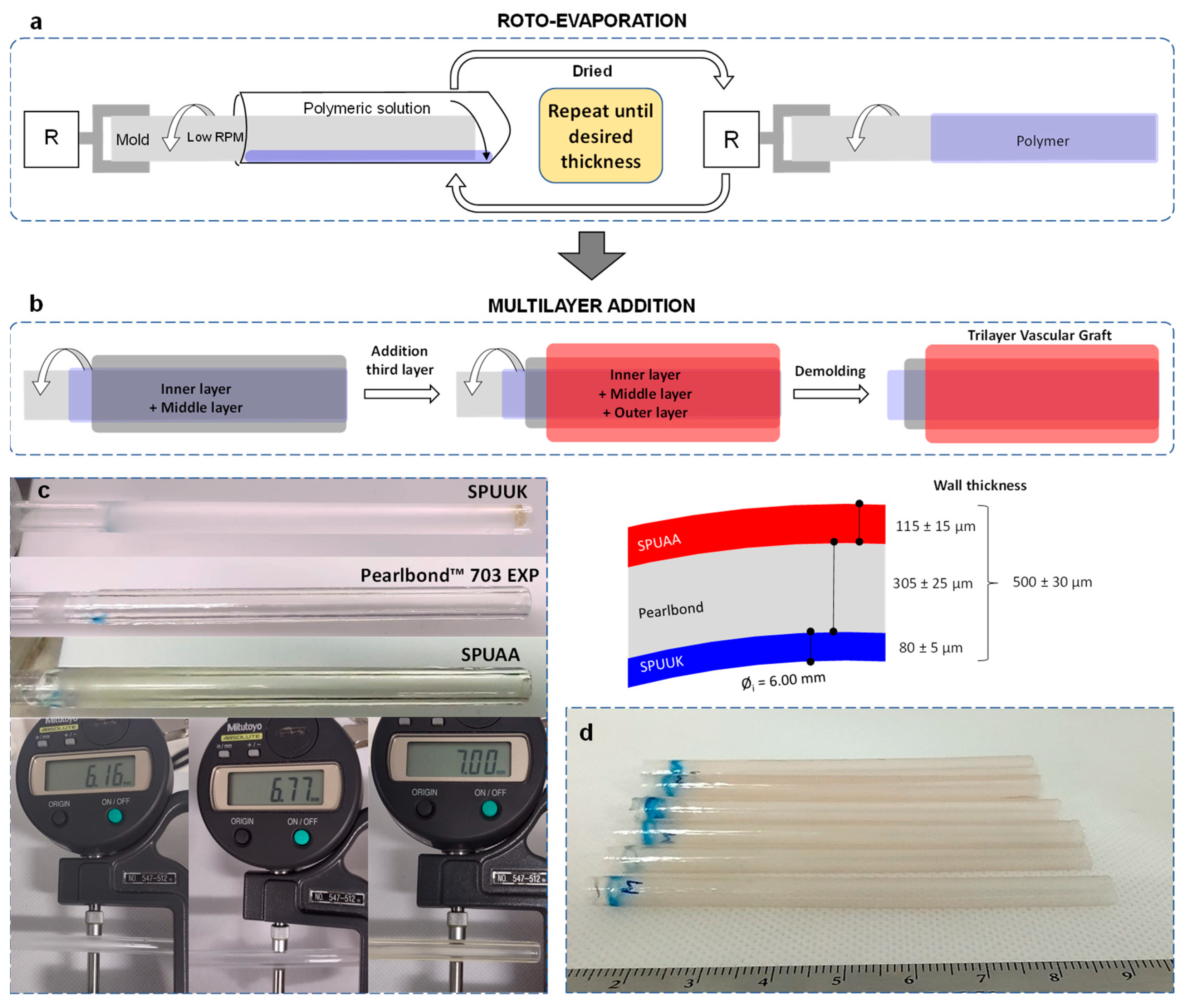
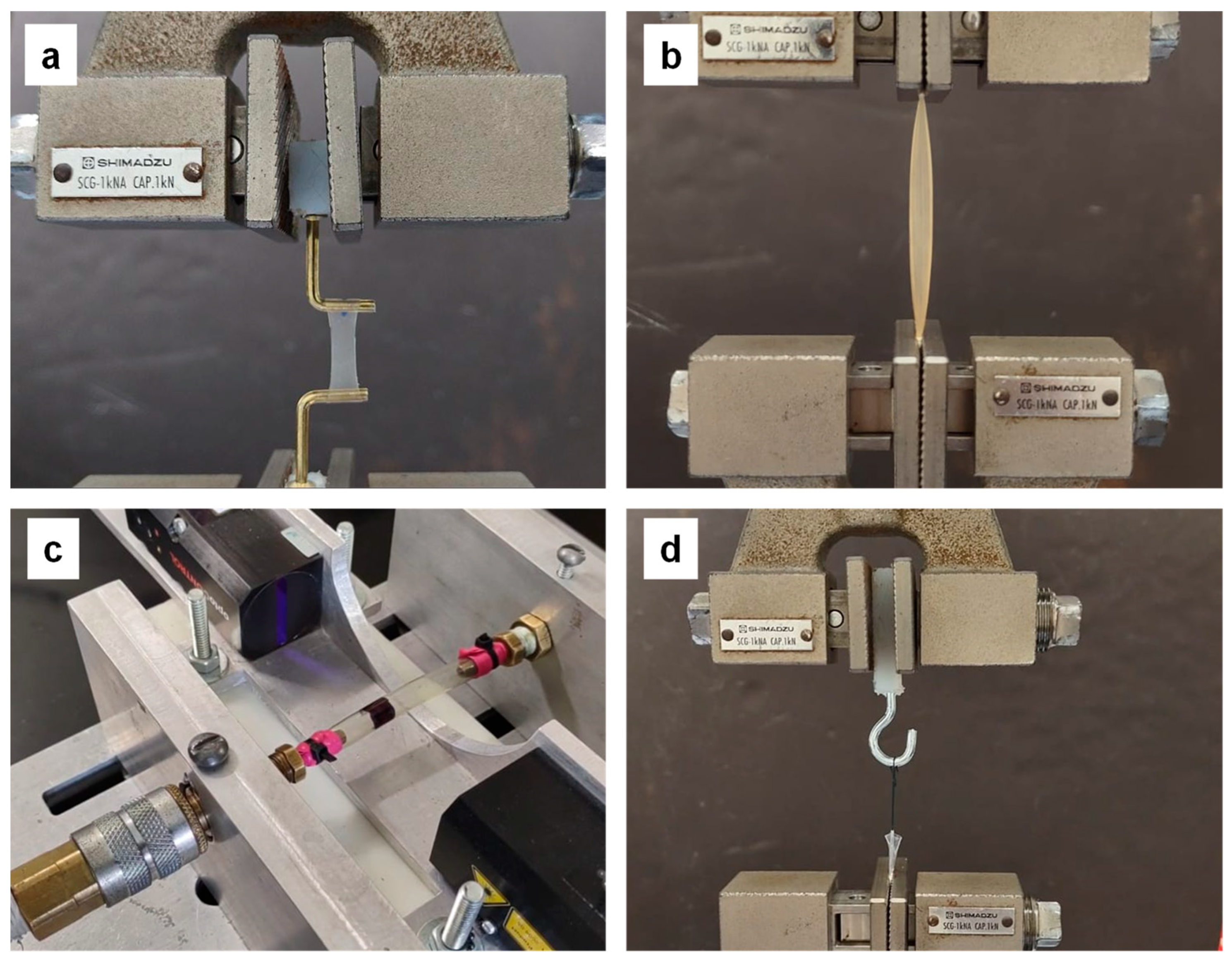

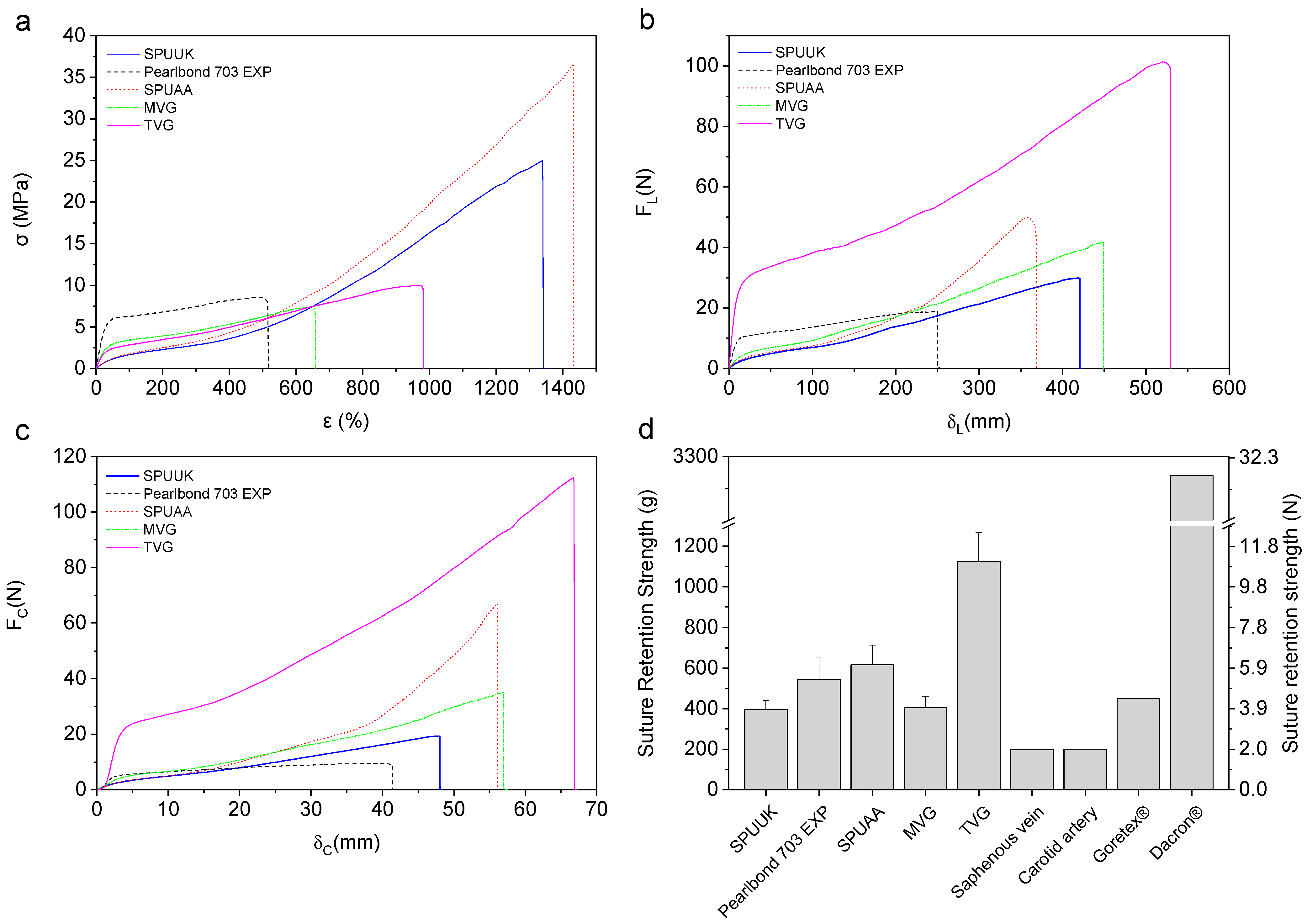
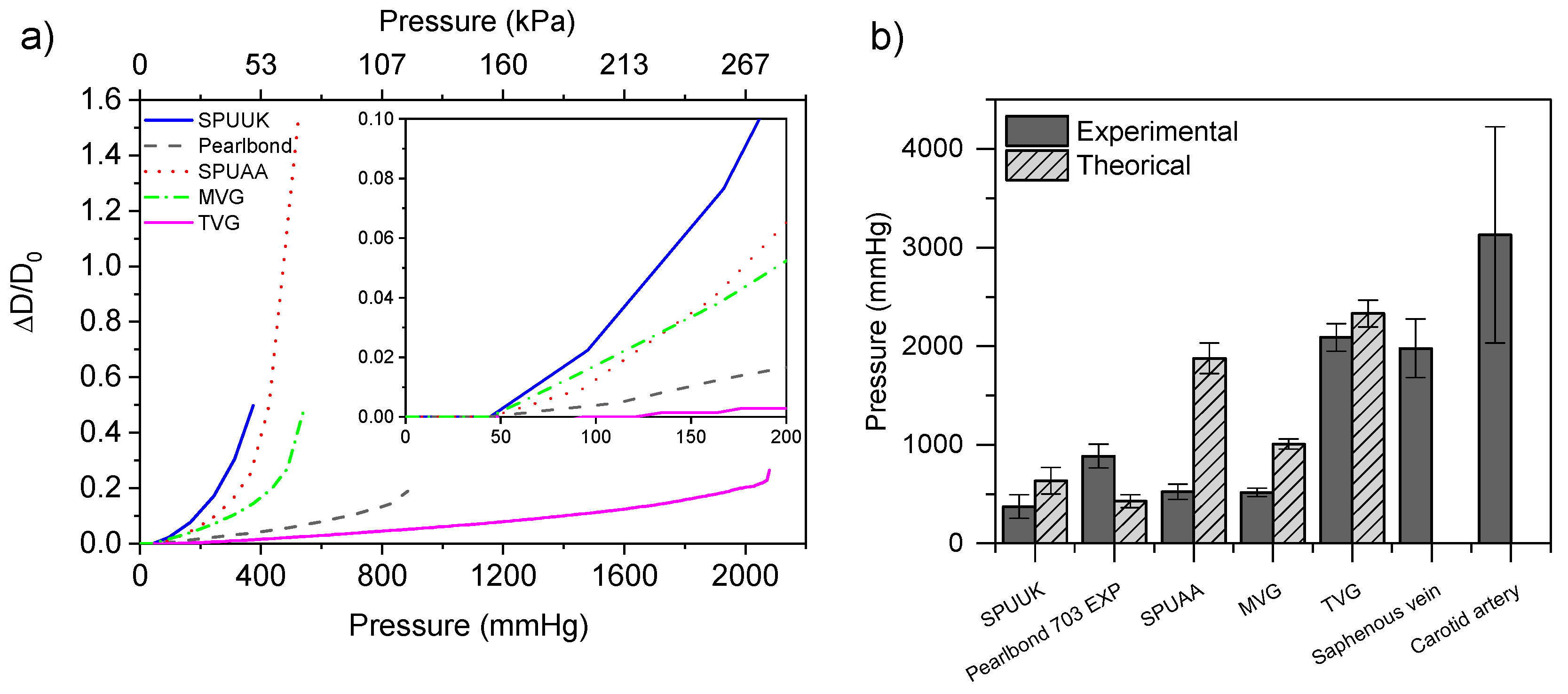

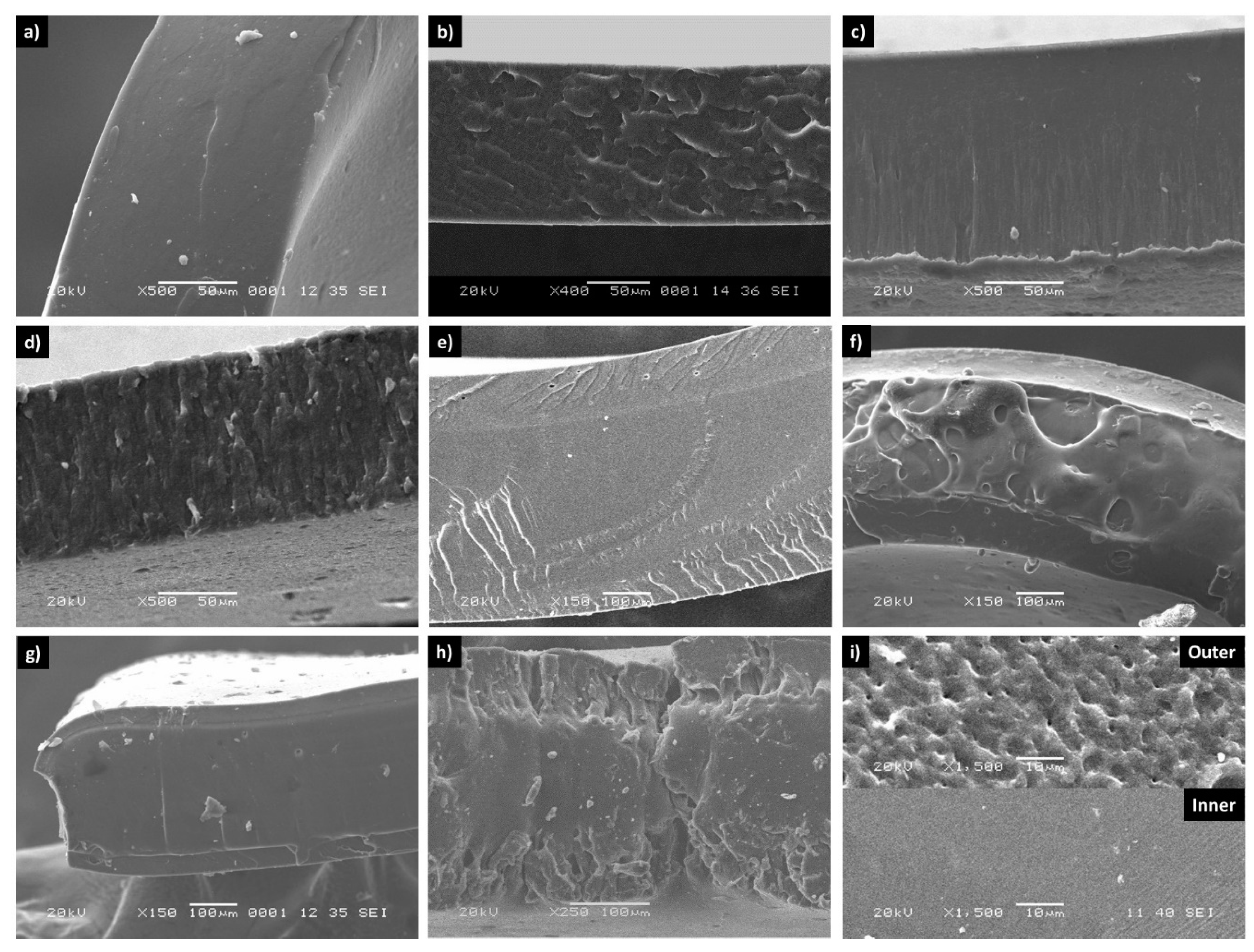
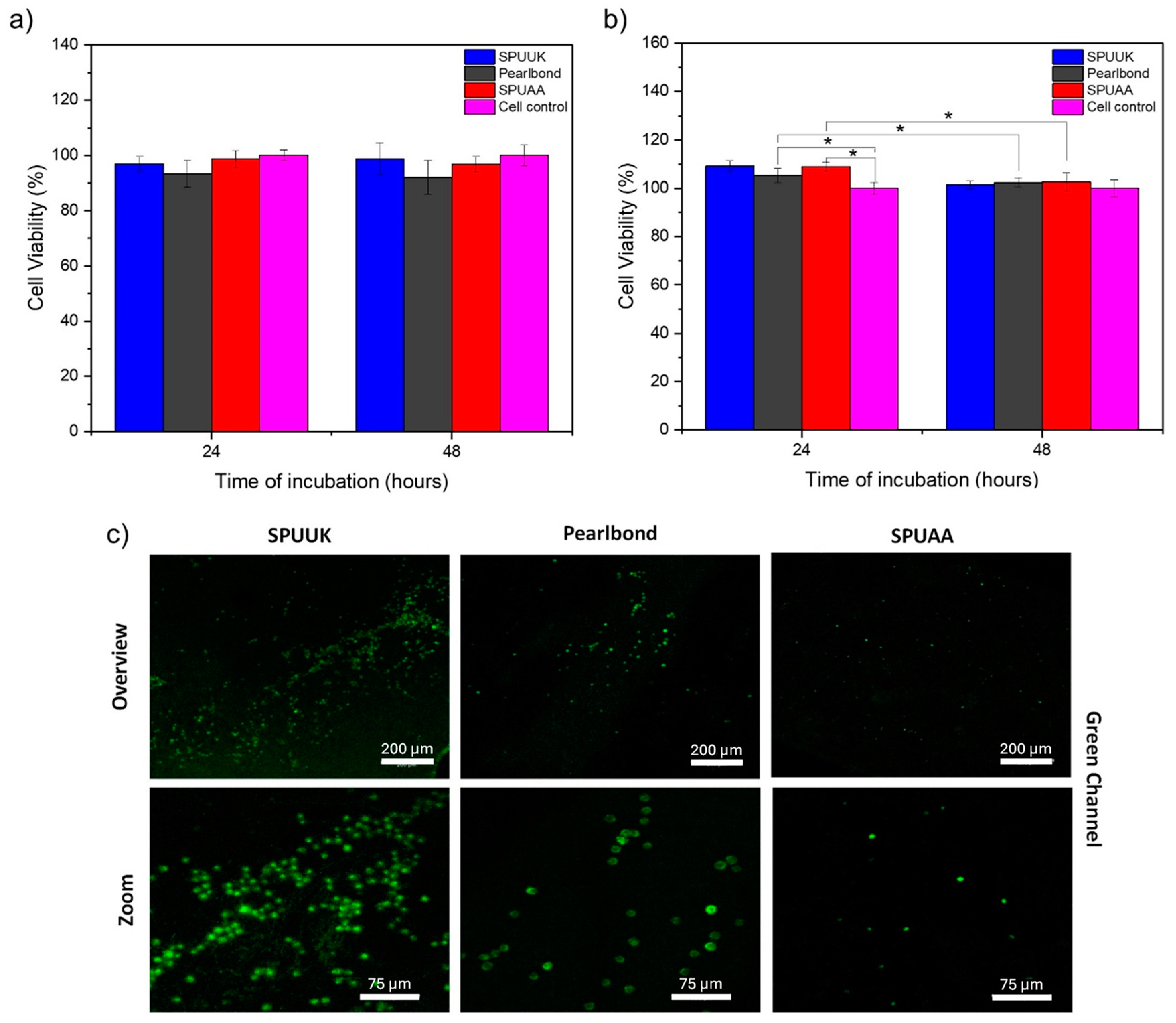
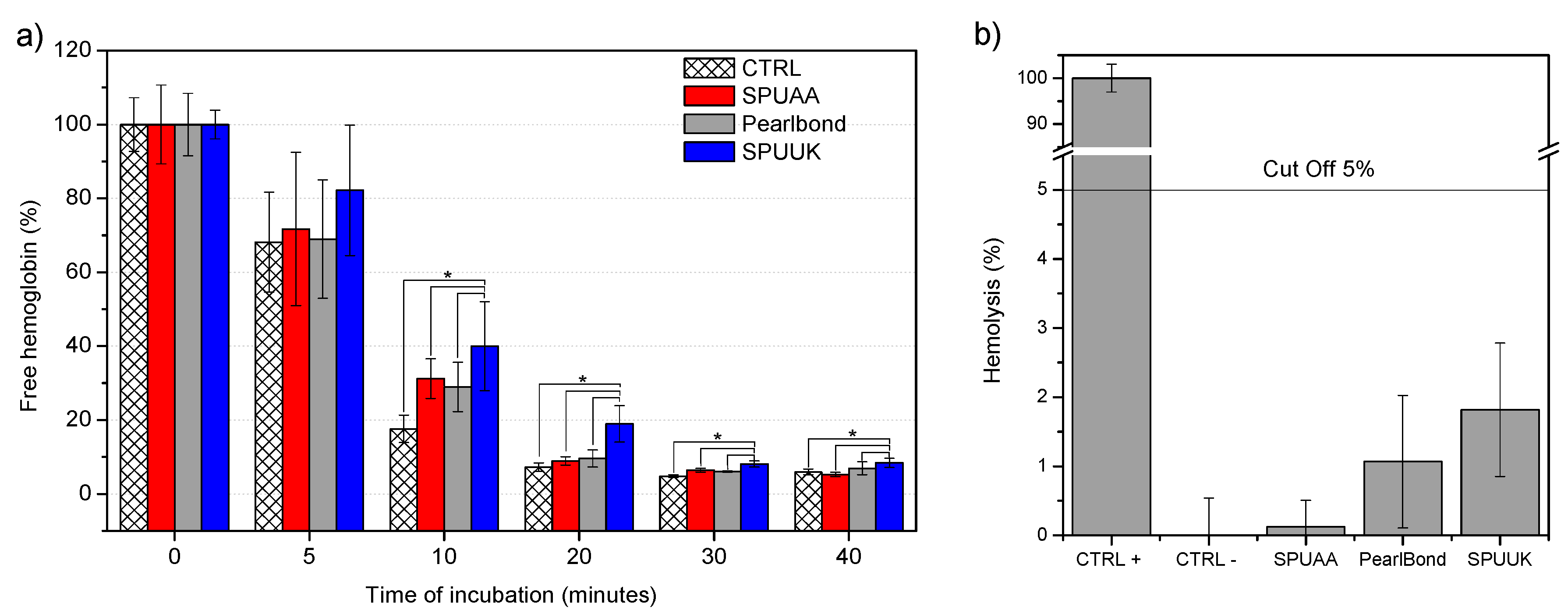
| SPUUK | Pearlbond 703 EXP | SPUAA | MVG | TVG b | |
|---|---|---|---|---|---|
| Film | |||||
| [MPa] | 3.4 ± 0.4 | 17.9 ± 3.3 | 3.3 ± 0.2 | 10.6 ± 0.3 | 9.3 ± 2.4 |
| [MPa] | 12.76 ± 1.42 | 7.04 ± 0.73 | 30.77 ± 4.11 | 6.8 ± 0.4 | 9.4 ± 1.6 |
| [%] | 1330 ± 125 | 521 ± 101 | 1430 ± 88 | 650 ± 83 | 930 ± 242 |
| [N] | 14.5 ± 2.5 | 3.5 ± 0.5 | 18.8 ± 2.3 | 4.0 ± 1.4 | 13.0 ± 3.1 |
| [mm] | 158 ± 14 | 59 ± 14 | 182 ± 17 | 65 ± 14 | 120 ± 31 |
| Graft (longitudinal) | |||||
| [N] | 26.1 ± 6.5 | 18.1 ± 4.3 | 49.8 ± 8.3 | 40.8 ± 5.2 | 101.3 ± 4.0 |
| [mm] | 404 ± 40 | 307 ± 86 | 373 ± 18 | 443 ± 26 | 484 ± 29 |
| Graft (circumferential) | |||||
| wall thickness [mm] | 0.130 ± 0.034 | 0.130 ± 0.019 | 0.130 ± 0.027 | 0.140 ± 0.01 | 0.499 ± 0.021 |
| [N/mm] | 1.49 ± 0.39 | 0.87 ± 0.11 | 5.00 ± 0.61 | 2.70 ± 0.20 | 7.17 ± 0.37 |
| [N] | 19.2 ± 4.9 | 11.3 ± 1.4 | 68.7 ± 8.5 | 37.3 ± 3.4 | 107.5 ± 6.1 |
| [mm] | 48.7 ± 4.5 | 42.2 ± 7.6 | 56.2 ± 2.8 | 56.9 ± 2.2 | 65.6 ± 1.8 |
| ‡ [MPa] | 11.55 ± 1.48 | 6.76 ± 0.88 | 40.10 ± 6.24 | 18.97 ± 1.49 | 14.49 ± 0.71 |
| Suture retention strength | |||||
| [N] | 3.9 ± 0.5 | 5.3 ± 1.1 | 6.0 ± 1.0 | 4.0 ± 0.6 | 11.0 ± 1.4 |
| F [g] | 396 ± 46 | 544 ± 111 | 616 ± 97 | 404 ± 57 | 1123 ± 144 |
| SPUUK | Pearlbond 703 EXP | SPUAA | MVG | TVG b | |
|---|---|---|---|---|---|
| Wall thickness [mm] | 0.132 ± 0.008 | 0.130 ± 0.012 | 0.142 ± 0.010 | 0.140 ± 0.004 | 0.500 ± 0.010 |
| External diameter [mm] | 6.27 ± 0.02 | 6.26 ± 0.02 | 6.29 ± 0.03 | 6.28 ± 0.01 | 7.01 ± 0.01 |
| Burst pressure [mmHg] | 373 ± 120 | 884 ± 120 | 517 ± 43 | 523 ± 78 | 2087 ± 139 |
| [mmHg] Df c | 634 ± 134 | 428 ± 66 | 1877 ± 155 | 1005 ± 51 | 2330 ± 136 |
| [mmHg] Du c | 3642 ± 936 | 2126 ± 267 | 12,230 ± 1517 | 6350 ± 628 | 15,834 ± 1372 |
| Deformation [%] | 49.3 ± 8.2 | 18.8 ± 2.6 | 151.5 ± 49.4 | 48.2 ± 7.6 | 40 ± 15.3 |
| C 50–90 [%100/mmHg] | 3.03 ± 1.06 | 0.88 ± 0.55 | 2.58 ± 0.54 | 2.53 ± 1.22 | 0.0 ± 0.0 |
| C 80–120 [%100/mmHg] | 5.21 ± 1.29 | 0.71 ± 0.4 | 4.13 ± 0.53 | 2.92 ± 0.93 | 0.15 ± 0.1 |
| C 110–150 [%/100 mmHg] | 6.81 ± 0.55 | 0.57 ± 0.46 | 5.1 ± 0.66 | 3.35 ± 0.65 | 0.44 ± 0.18 |
| Stiffness index 80–120 mmHg | 20.3 ± 3.9 | 143 ± 80 | 24.8 ± 3.2 | 37.6 ± 11.1 | 225 ± 150 |
Disclaimer/Publisher’s Note: The statements, opinions and data contained in all publications are solely those of the individual author(s) and contributor(s) and not of MDPI and/or the editor(s). MDPI and/or the editor(s) disclaim responsibility for any injury to people or property resulting from any ideas, methods, instructions or products referred to in the content. |
© 2024 by the authors. Licensee MDPI, Basel, Switzerland. This article is an open access article distributed under the terms and conditions of the Creative Commons Attribution (CC BY) license (https://creativecommons.org/licenses/by/4.0/).
Share and Cite
Zumbardo-Bacelis, G.A.; Peponi, L.; Vargas-Coronado, R.F.; Rodríguez-Velázquez, E.; Alatorre-Meda, M.; Chevallier, P.; Copes, F.; Mantovani, D.; Abraham, G.A.; Cauich-Rodríguez, J.V. A Comparison of Three-Layer and Single-Layer Small Vascular Grafts Manufactured via the Roto-Evaporation Method. Polymers 2024, 16, 1314. https://doi.org/10.3390/polym16101314
Zumbardo-Bacelis GA, Peponi L, Vargas-Coronado RF, Rodríguez-Velázquez E, Alatorre-Meda M, Chevallier P, Copes F, Mantovani D, Abraham GA, Cauich-Rodríguez JV. A Comparison of Three-Layer and Single-Layer Small Vascular Grafts Manufactured via the Roto-Evaporation Method. Polymers. 2024; 16(10):1314. https://doi.org/10.3390/polym16101314
Chicago/Turabian StyleZumbardo-Bacelis, Gualberto Antonio, Laura Peponi, Rossana Faride Vargas-Coronado, Eustolia Rodríguez-Velázquez, Manuel Alatorre-Meda, Pascale Chevallier, Francesco Copes, Diego Mantovani, Gustavo A. Abraham, and Juan Valerio Cauich-Rodríguez. 2024. "A Comparison of Three-Layer and Single-Layer Small Vascular Grafts Manufactured via the Roto-Evaporation Method" Polymers 16, no. 10: 1314. https://doi.org/10.3390/polym16101314
APA StyleZumbardo-Bacelis, G. A., Peponi, L., Vargas-Coronado, R. F., Rodríguez-Velázquez, E., Alatorre-Meda, M., Chevallier, P., Copes, F., Mantovani, D., Abraham, G. A., & Cauich-Rodríguez, J. V. (2024). A Comparison of Three-Layer and Single-Layer Small Vascular Grafts Manufactured via the Roto-Evaporation Method. Polymers, 16(10), 1314. https://doi.org/10.3390/polym16101314









